The Intel SSD 540s (480GB) Review
by Billy Tallis on June 23, 2016 9:00 AM ESTRandom Read Performance
The random read test requests 4kB blocks and tests queue depths ranging from 1 to 32. The queue depth is doubled every three minutes, for a total test duration of 18 minutes. The test spans the entire drive, which is filled before the test starts. The primary score we report is an average of performances at queue depths 1, 2 and 4, as client usage typically consists mostly of low queue depth operations.
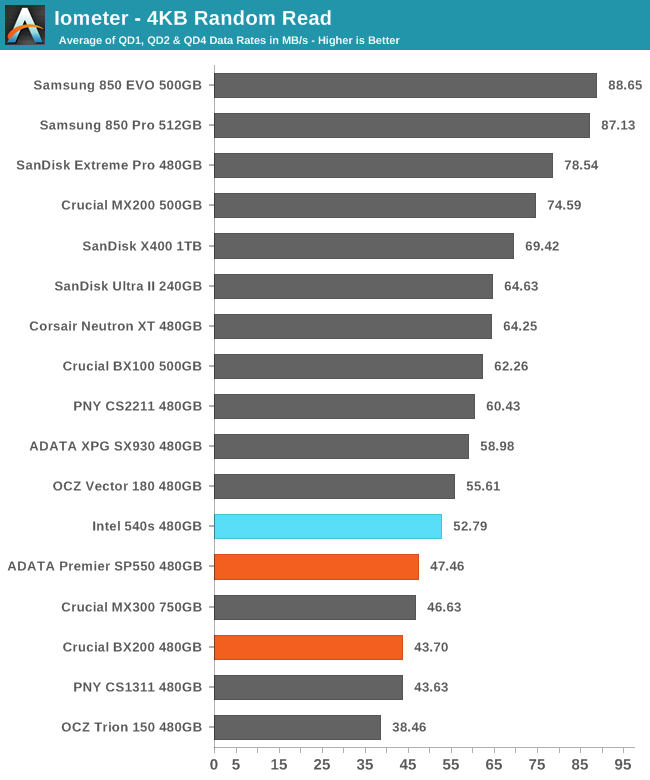
The random read speed of the Intel 540s is a significant improvement over both SM2256 drives and Phison S10 TLC drives, but isn't quite as fast as the MLC drives or SanDisk and Samsung TLC.
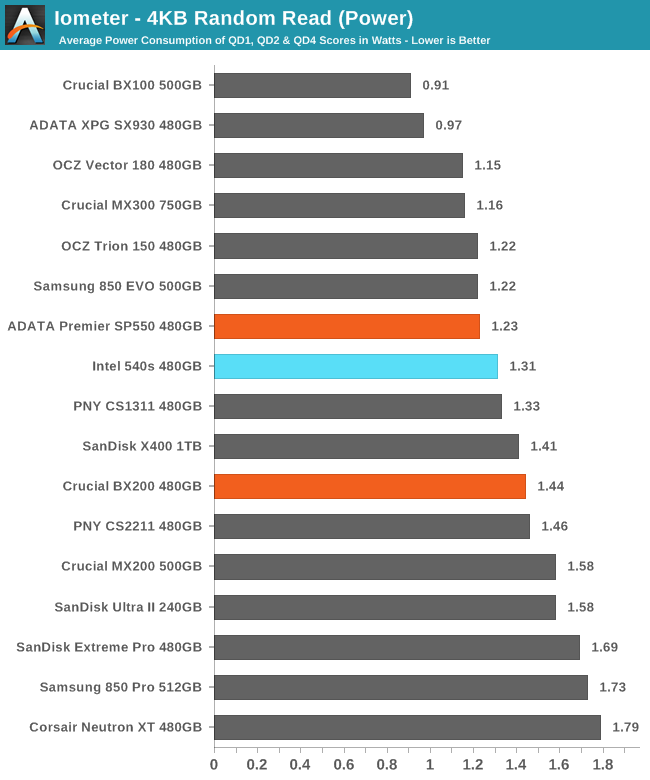
Power usage of the Intel 540s was slightly higher than the SP550, but given the performance increase their efficiency is similar and good overall.
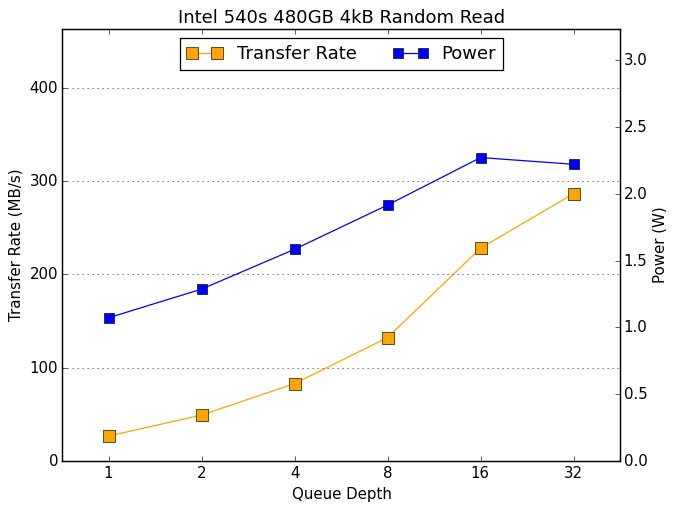 |
|||||||||
The Intel 540s drew more power and delivered more performance than the SP550 at every queue depth until QD32, where the SP550 performed slightly better.
Random Write Performance
The random write test writes 4kB blocks and tests queue depths ranging from 1 to 32. The queue depth is doubled every three minutes, for a total test duration of 18 minutes. The test is limited to a 16GB portion of the drive, and the drive is empty save for the 16GB test file. The primary score we report is an average of performances at queue depths 1, 2 and 4, as client usage typically consists mostly of low queue depth operations.
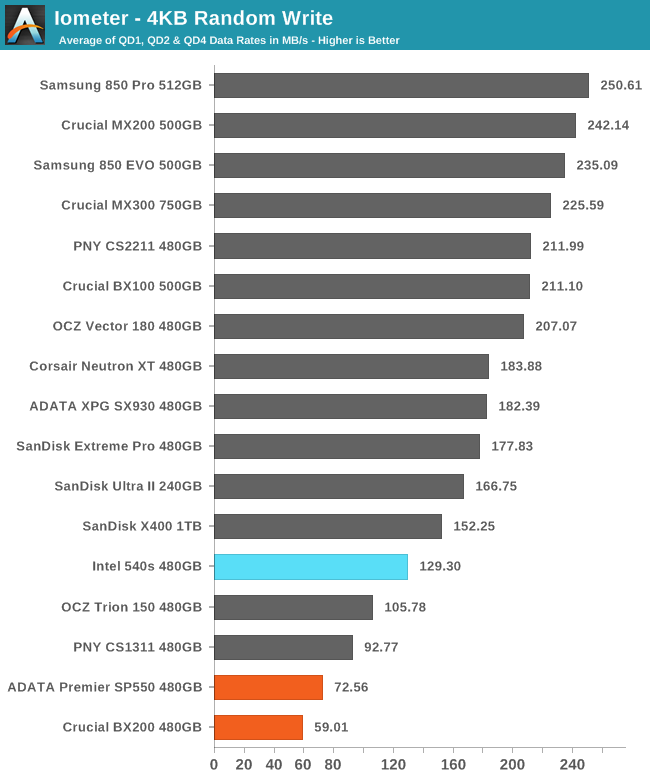
The Intel 540s shows almost double the performance on the random write test that the SM2256 drives did. This puts it well ahead of the Phison-based TLC drives and close to SanDisk's TLC drives.
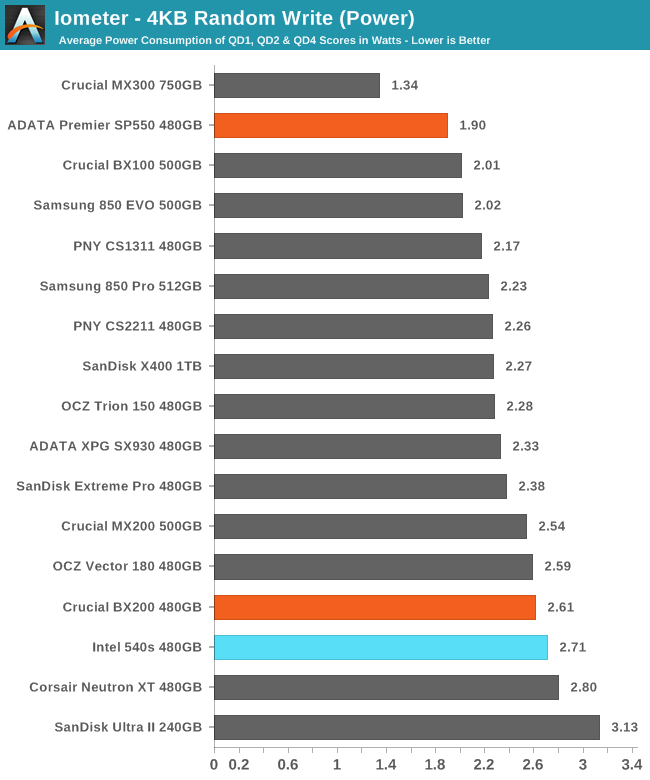
The Intel 540s had relatively high power draw during the random test, but it certainly wasn't the least efficient drive.
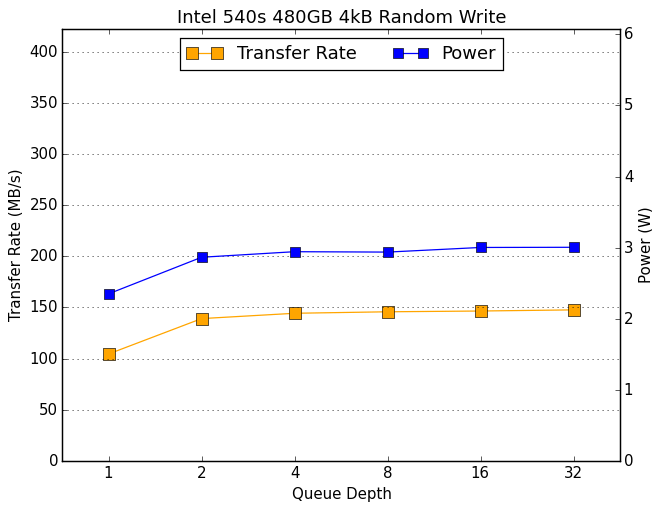 |
|||||||||
The random write performance of the Intel 540s increases moderately from QD1 to QD2 and only very slightly after that. The SM2256 drives started out slower and stayed there, though the BX200 drew more power with higher queue depths. Most budget TLC drives show relatively little scaling with queue depth here, with a few exceptions like the OCZ Trion 150 jumping up from QD4 and QD8.










77 Comments
View All Comments
doggface - Thursday, June 23, 2016 - link
I am ... Amazed that Intel would dirty their brand name like this. Truly a terrible controller, terrible flash, and a terrible idea.Intel has a brand name that generally speaks to quality parts. They should never have dabbled in the arena of TLC.
ddriver - Thursday, June 23, 2016 - link
Reveals optane, releases mediocrity... come on.Drumsticks - Thursday, June 23, 2016 - link
I actually worked on this for a short time last year, and I can say - working with SMI definitely is not as easy (at least for Intel) and was certainly more frustrating than developing in house.BurntMyBacon - Friday, June 24, 2016 - link
Any reason they didn't label a drive with this level of performance a 300 series drive?Drumsticks - Friday, June 24, 2016 - link
No idea, honestly. I think everything is just a 5xx SSD now (at least the SATA stuff). I think it's priced well above what I was expecting it to be priced at though, tbh.pwil - Wednesday, July 27, 2016 - link
300 series had 3y warranty.JoeyJoJo123 - Thursday, June 23, 2016 - link
HERE COMES THE SSD MEMES!>Muh MLC!
>Muh endurance!
>Muh data retention!
>Muh reliability!
>Muh random I/O!
>Muh this drive isn't exactly what I want in my PC, so instead of using PC Part Picker to find a suitable drive for my incredibly critical tastes, I'm going to post a comment on a news article expressing how disgusted I am by how this drive isn't up to _MY_ standards.
FUN FACT: Did you know that companies design products for people besides yourself?
b4bblefish - Thursday, June 23, 2016 - link
Meh... it's not that they make products for people besides us. It's that for the price it's a horrible deal. You can buy better more reliable drives for a lot cheaper especially if it's targeting the entry level consumer market. So why bother entering this segment and offer something without any value?JoeyJoJo123 - Thursday, June 23, 2016 - link
Because these drives are likely aimed at bulk government/corporate purchases, not really for consumers as the price/performance ratio is terrible. Government/corporate entities will end up buying bulk, even when the price isn't the best available, from what the business analysts approve as reputable companies; not because it's a wise purchase from an IT perspective.I guarantee you this: It's got an Intel sticker, so it'll be bought in droves by people who don't know, even if it sucks. See: Pentium 4.
And secondly, nobody should ever care for brand image. Every brand releases crap products from time to time. Some brands do this more often than others. Always evaluate products on an individual level, not because they happen to come from some "reputable" brand.
techconc - Thursday, June 23, 2016 - link
I agree with most of your post. However, you went off the rails with regard to brand image. Yes, you shouldn't buy based on brand image alone. However, all things being equal, brand reputation does come into play. Companies earn a reputation, for better or worse, based on the quality of the product they produce. Completely disregarding that history isn't very good advice.